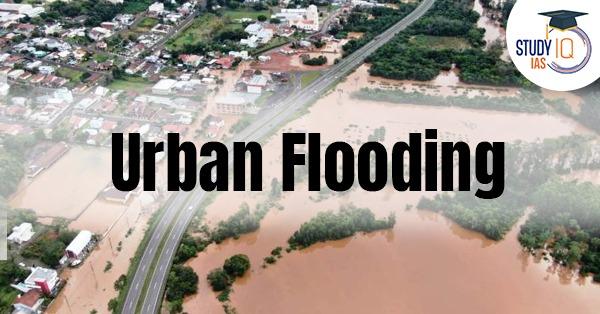Table of Contents
Urban Flooding: About
- Floods are a result of both meteorological —rainfall frequency and intensity, storms, temperature— and hydrological factors — groundwater levels, extent of impervious surface.
- When combined with anthropogenic factors in urban centres, they are classified as Urban Flooding.
- Characteristics of Urban Flooding
- Urban Flooding is significantly different from rural flooding as urbanization leads to developed catchments, which increases the flood peaks from 1.8 to 8 times and flood volumes by up to 6 times.
- Urban Flooding occurs very quickly due to faster flow times (in a matter of minutes).

Urban Flooding: Factors Leading
- Natural Factors of Urban Flooding:
- Heavy rainfall during monsoons
- Storm surges affect coastal cities/ towns.
- Sudden release or failure to release water from dams can also have severe impact.
- Urban heat island effect has resulted in an increase in rainfall over urban areas.
- Global climate change is resulting in changed weather patterns and increased episodes of high intensity rainfall events occurring in shorter periods of time.
- Increasing Urbanization: Over concretization resulting in reduced infiltration of rainwater into the soil and changes to the topography of the city lead to urban flooding.
- According to World Meteorological Organisation, both untreated sewage and toxic chemicals can pose significant threats to public health and the water supply.
- Unplanned Expansion: City master plans are focussed on protecting a small and fixed buffer area around identified water bodies and streams and fail to regulate the land market efficiently.
- Unplanned waste dumping and continuous disregard for natural recharge structures like ponds, wetlands, and tanks.
- Collapse of Local Infrastructure: Stormwater drains remain locked in decades-old networks, whose deficits are aggravated by the inefficiency of municipal bodies.
- In 2021, Comptroller and Auditor General raised questions about Bengaluru’s sewerage plan, especially the municipality’s failure to map the city’s tertiary drains, which have a critical role in managing run-off.
- Impropriety: Civic bodies are often guilty of impropriety in the use of resources.
- As per the findings of the CAG, Bengaluru municipality did not maintain proper records of the stormwater management funds allotted to it under the JNNURM.
- Poor Coordination: CAG noted the lack of coordination between the municipality and the Bangalore Development Authority on drainage-related matters.
- Lack of adequate resources with Municipalities: Municipal tax rates are far too low for local administrations to build, manage and renew public services and utilities efficiently.

Urban Flooding: Factors Responsible for Bengaluru
- Heavy rainfall during monsoon: Bengaluru witnessed its second wettest rainy season in 50 years which is a main cause of Urban Flooding.
- Encroachment of Wetlands: A large number of urban wetlands that soak up rainwater have been built upon, with more than 6,000 illegal layouts across the city.
- Urban Flooding currently, Bangaluru has 193 lakes and most of them have lost connectivity due to blocking of rajakaluves (storm water drains) with solid waste or because of encroachment which results Urban Flooding.
- Increasing city’s population: It is estimated to be more than one crore today, which was 1.6 lakh in 1901. This rapid and extreme growth has triggered a massive demand for land and its encroachment.
Urban Flooding: Flood Management Responsibility
- Urban Flooding: Flood management including erosion control falls within the purview of the States.
- Flood management and anti-erosion schemes are formulated and implemented by concerned State Governments as per their priority.
- The Union Government supplements the efforts of the States by providing technical guidance and also promotional financial assistance for management of floods in critical areas.
- Integrated flood management approach: It aims at adopting judicious mix of structural and non-structural measures to provide a reasonable degree of protection against flood damages at economic cost.
- Flood Management and Border Areas Programme (FMBAP): Government of India had implemented Flood Management Programme (FMP) during XI & XII Plan for providing Central Assistance to States for works related to flood control, anti-erosion, drainage development, anti-sea erosion, etc.





















 WhatsApp
WhatsApp